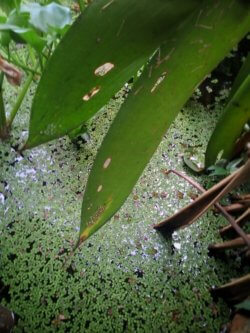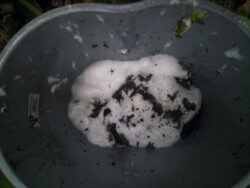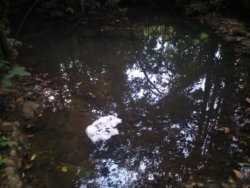Hello everyone. This morning when we arrived at the farm while we were reviewing one of the ponds of the property we found a strange foam floating on the water (Photo 1). This is a manner of egg laying by an amphibian

Photo 1: Amphibian egg laying, foam reduces predation. The central rectangle is a credit card-sized ID, for reference.
In this pond, a few days ago we had already located two sets of eggs of the red-eyed frog (Agalychnis callidryas) which are found in leaves that are on the water sheet. When the eggs open, the tadpoles jump into the water (Photo 2 and Photo 3).

Photo 2: Bromelia sp with two sets of eggs of Agalychnis callidryas

Photo 3: Detail of laying eggs of Agalychnis callidryas
Due to the size of the new egg laying mass found, we are concerned about competition for tadpole resources in the pond. The pond is very small, it is 1.5 m in diameter and 15 cm deep. So we proceeded to identify the species of amphibian that puts that type of laying. After reviewing a couple of books and articles on the internet, we identified that this is the genus leptodactylus and because the size of the laying is very large should be Leptodactylus savagei, one of the Costa Rican giant frog species. We sent the photos and the name of the specie, which we thought it was, to some friends who work with frogs.
We were quickly told that we were right, it was an egg laying Leptodactylus savagei. It’s was a big problem, not that they will be competing for food, the tadpoles of Leptodactylus savagei are carnivorous …. After evaluating it for a few hours and after reading about the feeding habits of these tadpoles, we made the decision to translocate them. Translocating an animal or plant species is when you transport it to another place where they can live on their own.
But first we had to know where we would place it; we started to talk about the different lakes and streams that we have available on the property. It had to be large, partially protected from sunlight and had food to feed the tadpoles. These tadpoles are carnivorous. It was decided to move the laying of eggs to a lake that had to be rebuilt recently. This lake, as a consequence of the manipulation, presents few species of animals, but many larvae of mosquitoes, which are a good food for the juveniles of Leptodactylus savagei.
We carefully picked it up in a big bucket (Photo 4). We carefully carried the egg mass inside the bucket and released it gently into the water of the lake. We will be watching them and waiting to see if we can see the little ones grow up.

Photo 4: laying eggs in the bucket for transport.
We hope to have increased the chances of survival of the red-eyed frog tadpoles (Agalychnis callidryas) and that the tadpoles of Leptodactylus savagei help us to control the mosquitoes in the lake, and when they grow we expect them to return to the lake and they put more eggs. Would help us to make the lake more natural and balanced. We hope you have enjoyed the story and we will be sharing more information about this story and others that will happen to us at Finca Nueva Luna. We left a photo of the egg laying of Leptodactylus savagei in its new home (Photo 5)

Photo 5: Egg mass after translocation.

